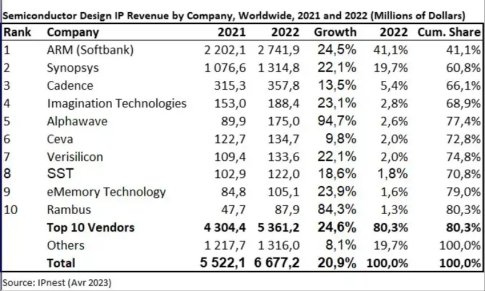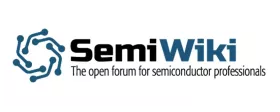Design IP Sales Grew 20.2% in 2022 after 19.4% in 2021 and 16.7% in 2020!
Design IP revenues had achieved $6.67B in 2022, after $5.56B in 2021, or 20.2% growth after 19.4% in 2021 and 16.7% in 2020. IPnest has released the “Design IP Report” in April 2023, ranking IP vendors by category (CPU, DSP, GPU & ISP, Wired Interface, SRAM Memory Compiler, Flash Memory Compiler, Library and I/O, AMS, Wireless Interface, Infrastructure and Misc. Digital) and by nature (License and Royalty).

The main trends shaking the Design IP in 2022 are very positive for most of the IP vendors, especially for 4 of the Top 5: ARM, Synopsys, Imagination and Alphawave growing by more than the market, respectively 24.5%, 22.1%, 23.1% and 94.7%. Rambus and Alphawave benefit from their recent IP vendor acquisition, PLDA, AnalogX and Hardent for the first, OpenFive for Alphawave, but their organic growth was already great. In summary, the Top 10 IP vendors have grown by 24.6%, when all others by 5.3%, this can be seen as an effect of consolidation, as a Top vendor will make proportionally more design win than “others”.
To read the full article, click here
Related Semiconductor IP
- Ultra-Low-Power LPDDR3/LPDDR2/DDR3L Combo Subsystem
- 1G BASE-T Ethernet Verification IP
- Network-on-Chip (NoC)
- Microsecond Channel (MSC/MSC-Plus) Controller
- 12-bit, 400 MSPS SAR ADC - TSMC 12nm FFC
Related Blogs
- Semi Market Decreased by 8% in 2023... When Design IP Sales Grew by 6%!
- Design IP Sales Grew 16.7% in 2020, Best Growth Rate Ever!
- Design IP Sales Grew 19.4% in 2021, confirm 2016-2021 CAGR of 9.8%
- Interface IP in 2022: 22% YoY growth still data-centric driven
Latest Blogs
- Rivian’s autonomy breakthrough built with Arm: the compute foundation for the rise of physical AI
- AV1 Image File Format Specification Gets an Upgrade with AVIF v1.2.0
- Industry’s First End-to-End eUSB2V2 Demo for Edge AI and AI PCs at CES
- Integrating Post-Quantum Cryptography (PQC) on Arty-Z7
- UA Link PCS customizations from 800GBASE-R Ethernet PCS Clause 172
